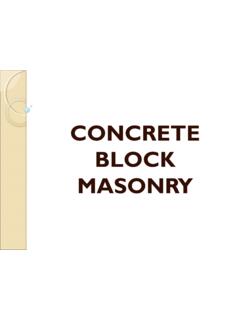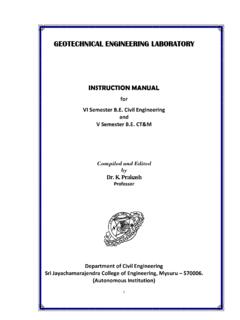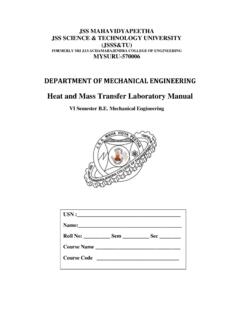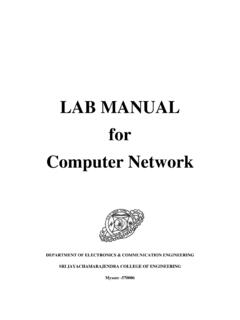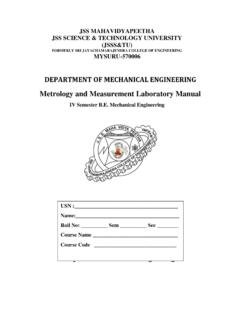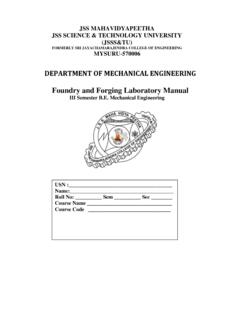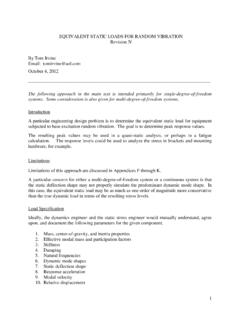Transcription of METHODS OF ANALYSIS FOR EARTHQUAKE RESISTANT …
1 METHODS OF ANALYSIS FOR EARTHQUAKE RESISTANT STRUCTURESIS 1893 (part-1) -2002Dr. G. P. ChandradharaProfessor, Dept. of Civil EngineeringS. J. College of Engineering, MysoreEmail: STANDARDS FOR EARTHQUAKE DESIGN IS : 1893 part -4 2002: Criteria For EARTHQUAKE Design Of Structures IS : 4326 1976: Code Of Practice For EarthquakeResistant Design And ConstructionOf Buildings IS : 13920 1993: Code Of Practice For Ductile DetailingOf Reinforced Concrete StructuresSubjected To Seismic Forces SP: 22 Explanatory Handbook On Codes For EARTHQUAKE frequencies of the structure (which is dependent on Mass (M) and Stiffness (K) content of of of characteristics (energy dissipation capacity) integrityResponse of structures during EARTHQUAKE depends on,STRUCTURAL RESPONSES tructural Response depends on Input motionStructural PropertiesUncertainties in Input motion When and where the next EARTHQUAKE On what fault ( location) On what magnitude Effect of travel path on shaking at a distance Effect of local geology, topography and soil profileEarthquake RESISTANT Design ConceptS tr o n g M o tio n Z o n eLevel 1 Maximum Credible EARTHQUAKE (MCE)The most severe EARTHQUAKE effects considered by this standard500 Years Return Period2 % Possibility of occurrence in 50 YrsLevel 2 Design Basis EARTHQUAKE (DBE))
2 It is the EARTHQUAKE which can reasonably be expectedto occur at least once during the design life of the structure250 Years Return Period10 % Possibility of occurrence in 50 YrsOBJECTIVES OF EQ RESISTANT ESIGN Should the structure be designed to withstand strong shaking without sustaining any damageSuch a construction will be too expensive It may be more logical to accept some damage in case of strong shaking However, loss of life must be protected enen in case of strong OF EQ RESISTANT DESIGNE arthquake RESISTANT Design Philosophy Building should resist minor earthquakes (<DBE) with some non-structural damage should resist moderate EARTHQUAKE (=DBE) with some structural damage, but without failure can fail at most severe EARTHQUAKE (=MCE), but with sufficient Max. EQ that can be expected to experience at the site once during life time of the structure. (DBE generally half of MCE)SEISMIC ZONE MAP OF INDIAF=m *aa = Z*gZ = Zone FactormF The varying geology at different locations in the country implies that the likelihood of damaging earthquakes taking place at different locations is different.
3 Thus a seismic zoning map is essential so that the structures located in different regions can be designed to withstand different level of ground shaking. The seismic zoning map is revised time to time based on the experience gained over the past occurrences of earthquakes. SEISMIC ZONE MAP t g t gEarthquake AccelerogramResponse of the StructureCONCEPT OF RESPONSE SPECTRUM-1 Find AmaxIt is a plot of the peak response (Velocity, Displacement or Acceleration) Period of SDOF system for a given Accelerogram. g t gEarthquake AccelerogramConcept of Response Spectrum -2 Find Response Amax in each case 1/1/2/1fiiiTmkf T1T2T3a2, maxa3, maxa1, maxTa, maxFor various values of Period of SDOF structures, Find Peak acceleration for the given input EARTHQUAKE acceleration and plotResponse (acc) v/s Rock or Hard Soil Medium Soil Soft SoilSa/gTime Period (secs)Response Spectrum IS : 1893 will not occur during EARTHQUAKE as the force is random & impulsive, not steady does not occur simultaneously with maximum wind, flood or sea properties (modulii, strength etc.)
4 Represent material behavior during EQRD Clause: OF FINDING THE EARTHQUAKE Lateral Force ( static Force) ANALYSIS Response Spectrum Method Time History (orstresses) ,onlythesemaximumstressesareofinterest, static load procedureBasis of Equivalent Lateral Force ( static Force) ProcedureVB = m aVB = (W/g) aVB = W (a/g)VB = W AhAh = Basic horizontal seismic coefficientVB = Base shearW = Total weight of the structurea = Acceleration induced at the base during earthquakeg = Acceleration due to gravitySEISMIC COEFFICIENT METHODA ssumptions Assume that structure is rigid. Assume perfect fixity between structure and foundation. During ground motion every point on the structure experience same accelerations Dominant effect of EARTHQUAKE is equivalent to horizontal force of varying magnitude over the height. Crudely determines the total horizontal force (Base shear) on the structureVB= W AhVB= W AhDuring an EARTHQUAKE structure does not remain rigid, it deflects, thus base shear is disturbed along the is modified to consider the following effects.
5 Natural period Damping Modal shapes Types of structure and place(zone) Subsoil conditions Importance of the structureBASIS OF SEISMIC COEFFICIENT Z=ZoneFactor Ss/g=SpectralAccelerationtakenfromRespon seSpectrum I=ImportanceFactor R=Ductility/Over-StrengthReductionFactor CALCULATION OF SEISMIC FORCE-1 Zone Factor & Multiplying Factor for Different Zone factor Z is for MCEFor DBE, it is Z/2 VALUES OF IMPORTANCEFACTOR -II-Importance factor, depending upon functional use of the structures, characterized by hazardous consequences of its failure, post- EARTHQUAKE functional needs, historical value , or economic importance (Table 6) Response Reduction Factor-RSl NoLateral Load Resisting SystemRBuilding Frame Systems1 Ordinary RC moment Resisting frame (OMRF) RC moment Resisting Frame (SMRF) Frames witha)Concentric Bracesb)Eccentric Moment Resisting Frame Designed as per SP 6(6) with Shear Walls45 Load Bearing Masonry Wall Buildings5a)Un-reinforcedb)Reinforced with Horizontal RC Bandsc)Reinforced with Horizontal RC Bands and Vertical barsAt corners of rooms and jambs of Reinforced Concrete Shear shear with Dual Systems88 Ordinary Shear wall with Shear wall with Shear wall with Shear wall with on the perceived seismic damage performance of the structure, characterized by ductile or brittle deformation However, the ratio (I/R) shall not be greater than (Table 7).
6 The values of R for buildings are given in Table for RC frame buildings for Steel frame buildings for all other buildings, moment resistingframes with Brick In-fill PanelsEMPIRICAL FORMULA FOR CALCULATION OF NATURAL Rock or Hard Soil Medium Soil Soft SoilSa/gTime Period (secs)Response Spectrum IS : 1893 n12ii2iiBihWhWVQDISTRIBUTION OF BASE SHEARQi Design lateral force at floor iWi Seismic Weight of floor i ( DL + LL)hi -Height of floor i measured from basen -Number of storey in the building(LL = 30% of Normal Live Load ) < 3 kN/m2)(LL = 50% of Normal Live Load) > 3 kN/m2)SEISMIC COEFFICIENT METHODD istribution of forces along the storeyFrameForceson storey levelSheardistributionhiVBQ4Q3Q2Q1Q4Q3Q2 Q1Q4Q3Q2Q1W4W3W2W1 n12ii2iiBihWhWVQDAMPING RATIO FOR DIFFERENT TYPES OF STRUCTURES STEEL STRUCTURE -2-5% CONCRETE STRUCTURE-5-10% BRICK STRUCTURE -5-10% TIMBER STRUCTURE -2-5% EARTHEN STRUCTURE -10-30%DYNAMIC ANALYSIS1. RESPONSE SPECTRUM METHODD istribution of forces at various story's is carried out usingmode shape, Participation Factors quantities ( BM, SF etc.
7 Are combined using CQC Complete Quadratic Here Period and mode shapes of the structure are obtained using free vibration ANALYSIS not from Empirical formula (Sa / g ) is obtained from the same response chart for all the modes separatelyMODE SHAPES OF OSCILLATION OF BUILDINGS iMode 1 Mode 2 Mode 3 Frame Lateral forces are found by superimposition of the Forces resulting from each modeObtain the design parameters by giving the actual EARTHQUAKE excitationDYNAMIC ANALYSIS2. TIME HISTORY ANALYSISTimeAccelerationa(t)TimeDisplace mentOver-riding of Response Parameters Computed From < (forexamplememberforces,displacements,st oreyforces,storeyshearsandbasereactions) shallbemultipliedbyVB1 OF PSEUDO static ANALYSIS AND DYNAMIC ANALYSISQ3Q2Q1a(t)Obtain Q1 Q3 using SCM or RSM Analyse the frame to obtain designBM & SF in SCM Analyse the frame to obtain BM & SFResponses are combined as per CQCmethod in RSM Directly we get design BM & SF inDynamic OF METHOD FOR MULTISTORIED BUILDINGPARTIAL SAFETY FACTORMATERIALS CONCRETE STEEL (DL + LL) (DL + LL EQ/WL) (DL EQ/WL) = 25% OF THE NORMAL LIVE LOADDESIGN MOMENTS IN (DL + LL) (DL + LL + EQ/WL) (DL + LL -EQ/WL) (DL + EQ/WL) (DL -EQ/WL) + MOMENTS IN MEMBERS-2 ( Ex.)
8 ABCL oadingEnd ACent-CEnd-BLoading-1-60+40-70 Loading-2+25+35-85 Loading-3-80+30+20 Loading-4+10+35-80 Loading-5-70+35-15 Loading-6+15+20-65 Loading-7-60+20+10 Design mom. -80/+25 +40 -85/ +20
